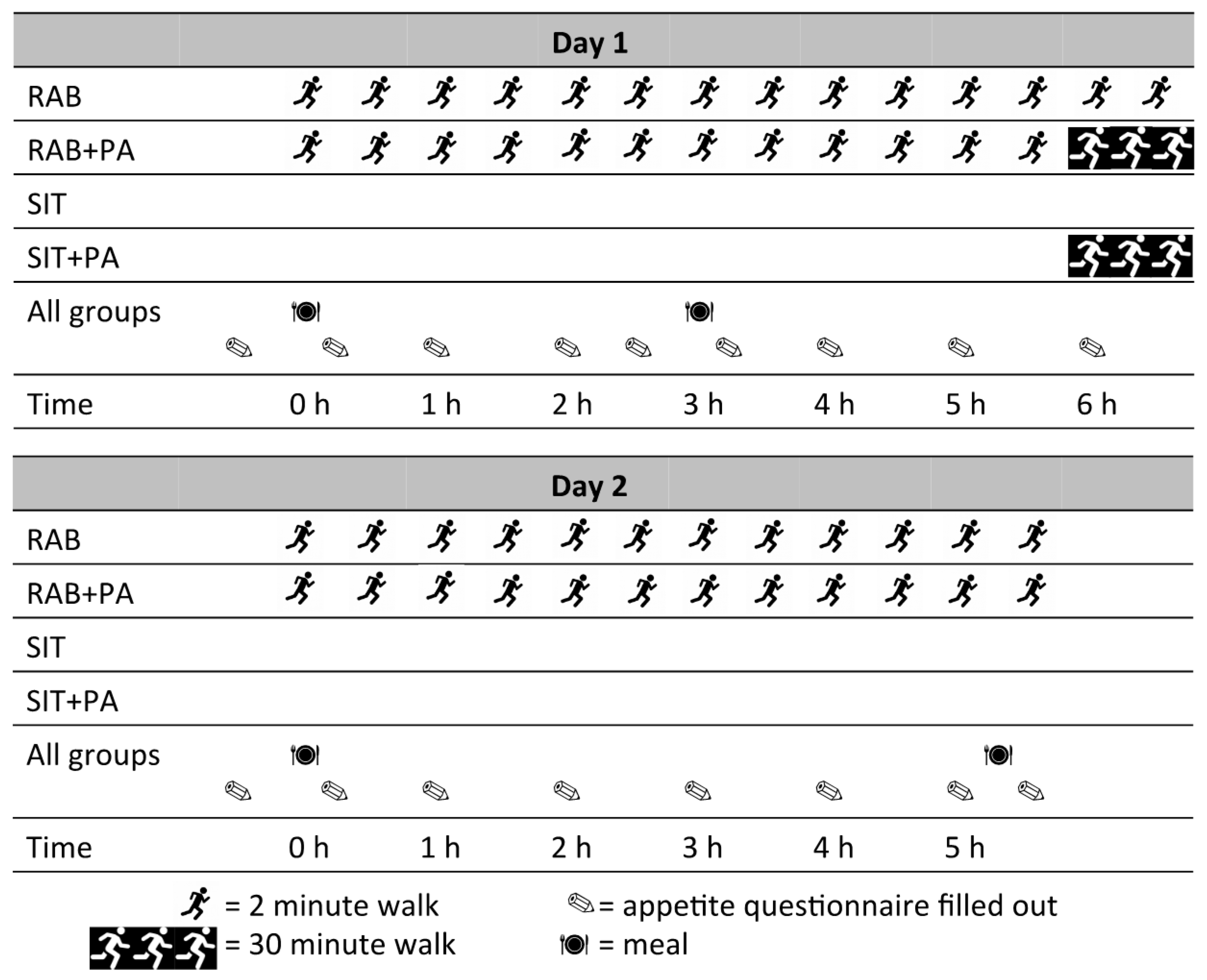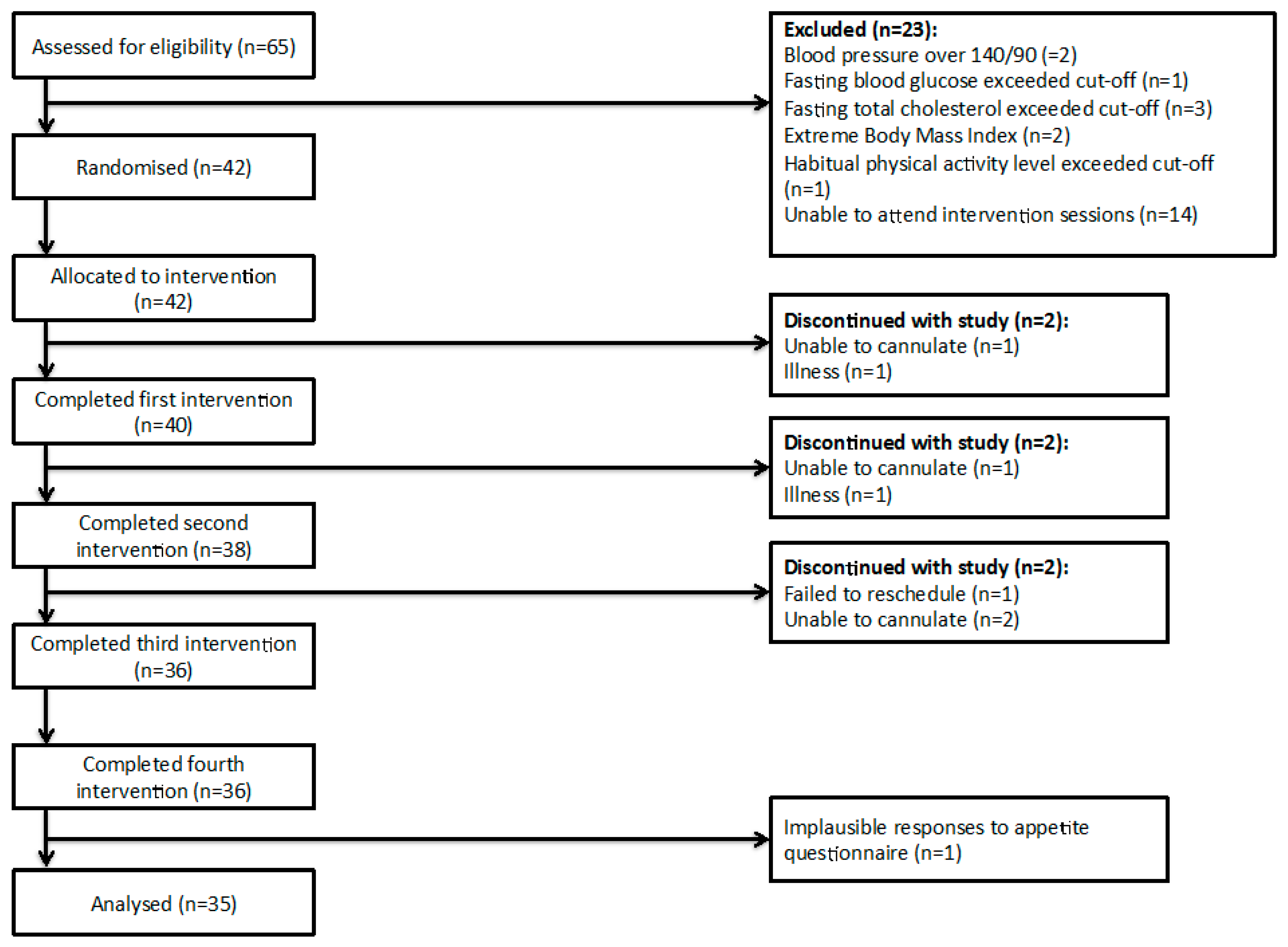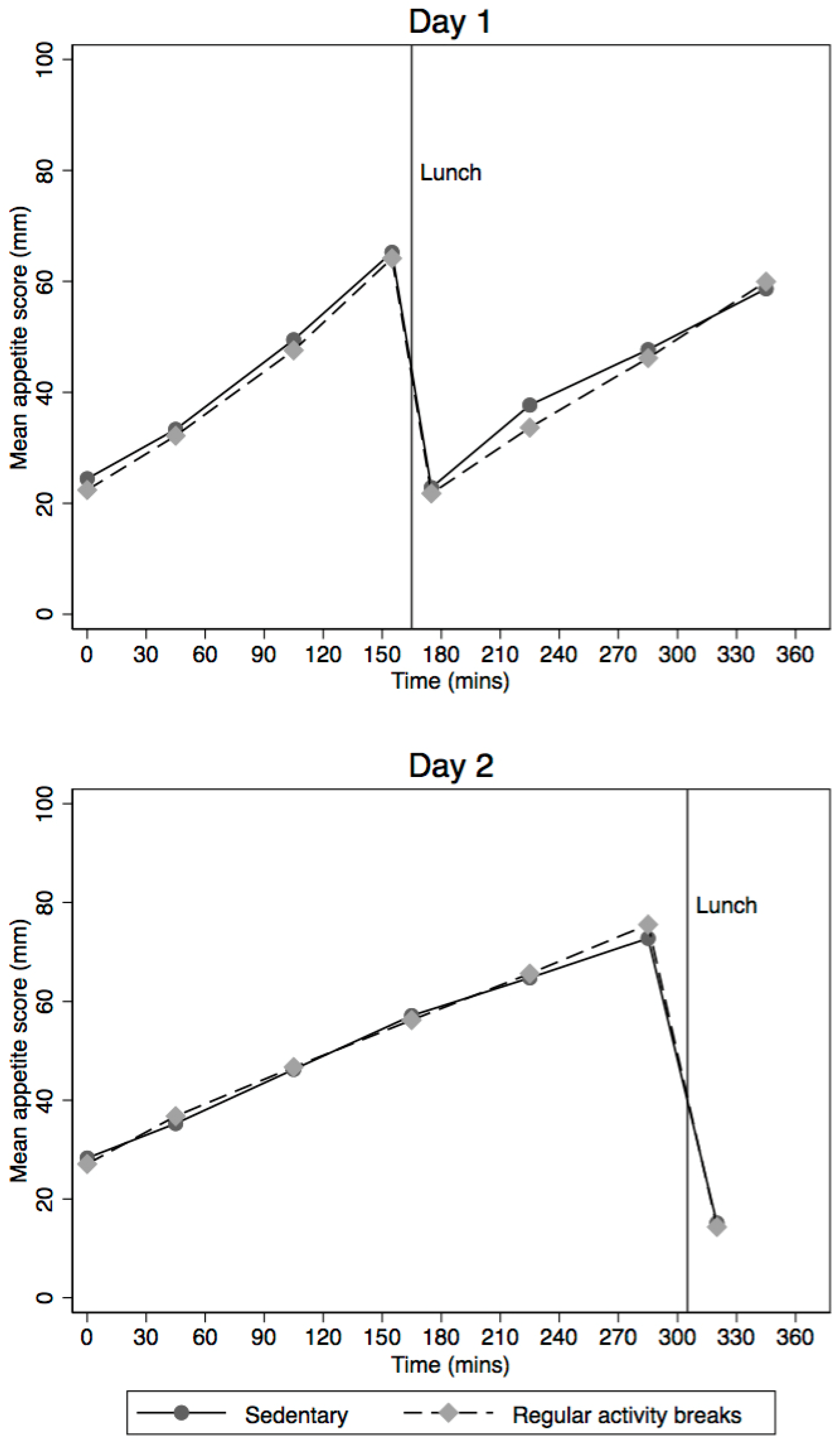Interrupting Prolonged Sitting with Regular Activity Breaks does not Acutely Influence Appetite: A Randomised Controlled Trial
Abstract
1. Introduction
2. Materials and Methods
2.1. Study Design
2.2. Participants
2.3. Preliminary Testing
2.4. Experimental Protocol
- (1)
- Prolonged Sitting (SIT): for both days, participants remained continuously seated, only moving from their chair to visit the bathroom when required (located six metres from seating area).
- (2)
- Prolonged Sitting with Physical Activity (SIT+PAD1): for both days, participants remained continuously seated, except for completing a 30 min treadmill walk at a speed and incline to elicit 60% VO2max at the end of Day 1 only. Time spent physically active: 30 min.
- (3)
- Regular Activity Breaks (RAB): for both days, sitting was interrupted every 28 min with a 2 min bout of walking on the treadmill at a speed and incline to elicit 60% VO2max Time spent physically active: 48 min.
- (4)
- Regular Activity Breaks with Physical Activity (RAB+PAD1): for both days, sitting was interrupted every 28 min with a 2 min bout of walking on the treadmill at a speed and incline to elicit 60% VO2max. In addition, at the end of Day 1 only participants completed a 30 min bout of continuous walking on the treadmill at a speed an incline to elicit 60% VO2max. Time spent physically active: 74 min.
2.5. Randomisation
2.6. Standardisation
2.7. Meal Composition
2.8. Ad Libitum Meal Protocol
2.9. Assessment of Appetite Response
2.10. Statistical Analysis
3. Results
4. Discussion
Acknowledgments
Author Contributions
Conflicts of Interest
References
- Sedentary Behaviour Research Network. Letter to the editor: Standardized use of the terms “sedentary” and “sedentary behaviours”. Appl. Physiol. Nutr. Metab. 2012, 37, 540–542. [Google Scholar]
- Biswas, A.; Oh, P.I.; Faulkner, G.E.; Bajaj, R.R.; Silver, M.A.; Mitchell, M.S.; Alter, D.A. Sedentary time and its association with risk for disease incidence, mortality, and hospitalization in adults: A systematic review and meta-analysis. Ann. Intern. Med. 2015, 162, 123–132. [Google Scholar] [CrossRef] [PubMed]
- De Rezende, L.F.; Rodrigues Lopes, M.; Rey-Lopez, J.P.; Matsudo, V.K.; Luiz Odo, C. Sedentary behavior and health outcomes: An overview of systematic reviews. PLoS ONE 2014, 9, e105620. [Google Scholar] [CrossRef] [PubMed]
- Bailey, D.P.; Locke, C.D. Breaking up prolonged sitting with light-intensity walking improves postprandial glycemia, but breaking up sitting with standing does not. J. Sci. Med. Sport 2015, 18, 294–298. [Google Scholar] [CrossRef] [PubMed]
- Dunstan, D.W.; Kingwell, B.A.; Larsen, R.; Healy, G.N.; Cerin, E.; Hamilton, M.T.; Shaw, J.E.; Bertovic, D.A.; Zimmet, P.Z.; Salmon, J.; et al. Breaking up prolonged sitting reduces postprandial glucose and insulin responses. Diabetes Care 2012, 35, 976–983. [Google Scholar] [CrossRef] [PubMed]
- Holmstrup, M.; Fairchild, T.; Keslacy, S.; Weinstock, R.; Kanaley, J. Multiple short bouts of exercise over 12-h period reduce glucose excursions more than an energy-matched single bout of exercise. Metab. Clin. Exp. 2014, 63, 510–519. [Google Scholar] [CrossRef] [PubMed]
- Peddie, M.C.; Bone, J.L.; Rehrer, N.J.; Skeaff, C.M.; Gray, A.R.; Perry, T.L. Breaking prolonged sitting reduces postprandial glycemia in healthy, normal-weight adults: A randomized crossover trial. Am. J. Clin. Nutr. 2013, 98, 358–366. [Google Scholar] [CrossRef] [PubMed]
- Carter, S.E.; Jones, M.; Gladwell, V.F. Energy expenditure and heart rate response to breaking up sedentary time with three different physical activity interventions. Nutr. Metab. Cardiovasc. Dis. 2015, 25, 503–509. [Google Scholar] [CrossRef] [PubMed]
- Swartz, A.M.; Squires, L.; Strath, S.J. Energy expenditure of interruptions to sedentary behavior. Int. J. Behav. Nutr. Phys. Act. 2011, 8, 69. [Google Scholar] [CrossRef] [PubMed]
- Stubbs, R.J.; Hughes, D.A.; Johnstone, A.M.; Horgan, G.W.; King, N.; Blundell, J.E. A decrease in physical activity affects appetite, energy, and nutrient balance in lean men feeding ad libitum. Am. J. Clin. Nutr. 2004, 79, 62–69. [Google Scholar] [PubMed]
- Stensel, D.J.; King, J.A.; Thackray, A.E. Role of physical activity in regulating appetite and body fat. Nutr. Bull. 2016, 41, 314–322. [Google Scholar] [CrossRef]
- Bailey, D.P.; Broom, D.R.; Chrismas, B.C.R.; Taylor, L.; Flynn, E.; Hough, J. Breaking up prolonged sitting time with walking does not affect appetite or gut hormone concentrations but does induce an energy deficit and suppresses postprandial glycaemia in sedentary adults. Appl. Physiol. Nutr. Metabol. 2016, 41, 324–331. [Google Scholar] [CrossRef] [PubMed]
- Bergouignan, A.; Legget, K.T.; De Jong, N.; Kealey, E.; Nikolovski, J.; Groppel, J.L.; Jordan, C.; O’Day, R.; Hill, J.O.; Bessesen, D.H. Effect of frequent interruptions of prolonged sitting on self-perceived levels of energy, mood, food cravings and cognitive function. Int. J. Behav. Nutr. Phys. Act. 2016, 13, 113. [Google Scholar] [CrossRef] [PubMed]
- Holmstrup, M.E.; Fairchild, T.J.; Keslacy, S.; Weinstock, R.S.; Kanaley, J.A. Satiety, but not total PYY, is increased with continuous and intermittent exercise. Obesity 2013, 21, 2014–2020. [Google Scholar] [CrossRef] [PubMed]
- Homer, A.R.; Fenemor, S.P.; Perry, T.L.; Rehrer, N.J.; Cameron, C.M.; Skeaff, C.M.; Peddie, M.C. Regular activity breaks combined with physical activity improve postprandial plasma triglyceride, nonesterified fatty acid, and insulin responses in healthy, normal weight adults: A randomized crossover trial. J. Clin. Lipidol. 2017, 11, 1268–1279. [Google Scholar] [CrossRef] [PubMed]
- Jones, B.; Kenward, M. Design and Analysis of Cross-Over Trials; Chapman and Hall: London, UK, 1989. [Google Scholar]
- Sivakumaran, S.; Huffman, L. The Concise New Zealand Food Composition Tables, 11th ed.; Ministry of Health, Ed.; The New Zealand Institute for Plant & Food Research Limited and Ministry of Health: Palmerston North, New Zealand, 2014.
- Ministry of Health; National Health and Medical Research Council. Nutrient Reference Values for Australia and New Zealand; National Health and Medical Research Council: Canberra, CBR, Australia, 2005.
- University of Otago and Ministry of Health. A Focus on Nutrition: Key Findings of the 2008/09 New Zealand Adult Nutrition Survey; Ministry of Health, Ed.; Ministry of Health: Wellington, New Zealand, 2011.
- Flint, A.; Raben, A.; Blundell, J.E.; Astrup, A. Reproducibility, power and validity of visual analogue scales in assessment of appetite sensations in single test meal studies. Int. J. Obes. Relat. Metab. Disord. 2000, 24, 38–48. [Google Scholar] [CrossRef] [PubMed]
- Farah, N.M.; Gill, J.M. Effects of exercise before or after meal ingestion on fat balance and postprandial metabolism in overweight men. Br. J. Nutr. 2013, 109, 2297–2307. [Google Scholar] [CrossRef] [PubMed]
- Sullivan, G.M.; Feinn, R. Using effect size—Or Why the p value is not enough. J. Grad. Med. Educ. 2012, 4, 279–282. [Google Scholar] [CrossRef] [PubMed]
- Fenemor, S.P. Energy Expenditure and Substrate Oxidation Associated with Prolonged Sitting, Regular Activity Breaks and Physical Activity. Master’s Thesis, University of Otago, Dunedin, New Zealand, 2016. [Google Scholar]
- Campbell, S.D.I.; Brosnan, B.J.; Chu, A.K.Y.; Skeaff, C.M.; Rehrer, N.J.; Perry, T.L.; Peddie, M.C. Sedentary behavior and body weight and composition in adults: A systematic review and meta-analysis of prospective studies. Sports Med. 2017. [Google Scholar] [CrossRef] [PubMed]
- Healy, G.N.; Dunstan, D.W.; Salmon, J.; Cerin, E.; Shaw, J.E.; Zimmet, P.Z.; Owen, N. Breaks in sedentary time: Beneficial associations with metabolic risk. Diabetes Care 2008, 31, 661–666. [Google Scholar] [CrossRef] [PubMed]
- Healy, G.N.; Matthews, C.E.; Dunstan, D.W.; Winkler, E.A.; Owen, N. Sedentary time and cardio-metabolic biomarkers in US adults: NHANES 2003–06. Eur. Heart J. 2011, 32, 590–597. [Google Scholar] [CrossRef] [PubMed]
- Knutson, K.L. Impact of sleep and sleep loss on glucose homeostasis and appetite regulation. Sleep Med. Clin. 2007, 2, 187–197. [Google Scholar] [CrossRef] [PubMed]
- Vincent, G.E.; Jay, S.M.; Sargent, C.; Kovac, K.; Vandelanotte, C.; Ridgers, N.D.; Ferguson, S.A. The impact of breaking up prolonged sitting on glucose metabolism and cognitive function when sleep is restricted. Neurobiol. Sleep Circadian Rhythms 2017, in press. [Google Scholar] [CrossRef]



| Day One | Day Two | ||||
|---|---|---|---|---|---|
| Breakfast | Lunch | Dinner | Total | Breakfast | |
| Energy (kJ/kg) | 32.65 | 26.17 | 62.75 | 121.57 | 43.24 |
| Carbohydrate (g/kg) | 1.07 | 0.99 | 1.48 | 3.54 | 0.71 |
| Fat (g/kg) | 0.23 | 0.12 | 0.71 | 1.06 | 0.70 |
| Protein (g/kg) | 0.27 | 0.11 | 1.47 | 1.85 | 0.32 |
| Characteristic | Mean (S.D.) |
|---|---|
| Age (years) | 25.4 (3.9) |
| Sex (female) | 24 (69) a |
| BMI (kg/m2) | 23.9 (3.9) |
| Systolic blood pressure (mmHg) | 121 (9) |
| Diastolic blood pressure (mmHg) | 74 (8) |
| Minutes of weekly activity | 120 (70) |
| Total cholesterol (mmol/L) b | 4.4 (0.7) |
| TAGs (mmol/L) b | 0.98 (0.37) |
| LDL cholesterol (mmol/L) b | 2.5 (0.68) |
| HDL cholesterol (mmol/L) b | 1.5 (0.35) |
| Blood glucose (mmol/L) b | 4.96 (0.37) |
| SITcombine AUC Mean (S.D.) (mm·min) | RABcombine AUC Mean (S.D.) (mm·min) | Mean Difference (95% CI) (mm·min) | Standardised Effect (95% CI) | p-Value a | |
|---|---|---|---|---|---|
| Appetite response to breakfast on Day 1 | 6624 (2427) | 6403 (2297) | −225 (−730, 281) | −0.08 (−0.27, 0.11) | 0.383 |
| Appetite response to breakfast on Day 2 | 6882 (2522) | 7049 (2379) | 129 (−343, 601) | 0.05 (−0.13, 0.23) | 0.593 |
| Combined b appetite response to breakfast | 6783 (2330) | 6726 (2164) | −55 (−437, 326) | −0.02 (−0.16, 0.12) | 0.777 |
| Overall c appetite response over Day 1 | 14,778 (5201) | 14,191 (4750) | −583 (−1499, 333) | 0.11 (−0.28, 0.06) | 0.212 |
| Overall c appetite response over Day 2 | 16,800 (4058) | 16,978 (3887) | 195 (−643, 1033) | 0.04 (−0.15, 0.24) | 0.648 |
| SITcombine Mean (S.D.) | RABcombine Mean (S.D.) | Mean Difference between Interventions (95% CI) | p-Value a | |
|---|---|---|---|---|
| Amount ad libitum lunch consumed (g) | 470 (181) | 487 (195) | 17 (−12, 46) | 0.253 |
| Mean appetite score b before ad libitum lunch (mm) | 73 (13) | 76 (12) | 2.6 (−6.0, 0.8) | 0.131 |
| Mean difference in appetite score b after ad libitum lunch compared to before (mm) | −58 (20) | −61 (17) | −0.8 (−3.7, 2.1) | 0.594 |
© 2018 by the authors. Licensee MDPI, Basel, Switzerland. This article is an open access article distributed under the terms and conditions of the Creative Commons Attribution (CC BY) license (http://creativecommons.org/licenses/by/4.0/).
Share and Cite
Mete, E.M.; Perry, T.L.; Haszard, J.J.; Homer, A.R.; Fenemor, S.P.; Rehrer, N.J.; Skeaff, C.M.; Peddie, M.C. Interrupting Prolonged Sitting with Regular Activity Breaks does not Acutely Influence Appetite: A Randomised Controlled Trial. Nutrients 2018, 10, 125. https://doi.org/10.3390/nu10020125
Mete EM, Perry TL, Haszard JJ, Homer AR, Fenemor SP, Rehrer NJ, Skeaff CM, Peddie MC. Interrupting Prolonged Sitting with Regular Activity Breaks does not Acutely Influence Appetite: A Randomised Controlled Trial. Nutrients. 2018; 10(2):125. https://doi.org/10.3390/nu10020125
Chicago/Turabian StyleMete, Evelyn M., Tracy L. Perry, Jillian J. Haszard, Ashleigh R. Homer, Stephen P. Fenemor, Nancy J. Rehrer, C. Murray Skeaff, and Meredith C. Peddie. 2018. "Interrupting Prolonged Sitting with Regular Activity Breaks does not Acutely Influence Appetite: A Randomised Controlled Trial" Nutrients 10, no. 2: 125. https://doi.org/10.3390/nu10020125
APA StyleMete, E. M., Perry, T. L., Haszard, J. J., Homer, A. R., Fenemor, S. P., Rehrer, N. J., Skeaff, C. M., & Peddie, M. C. (2018). Interrupting Prolonged Sitting with Regular Activity Breaks does not Acutely Influence Appetite: A Randomised Controlled Trial. Nutrients, 10(2), 125. https://doi.org/10.3390/nu10020125






